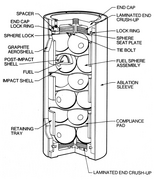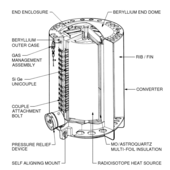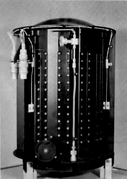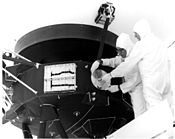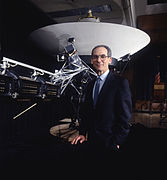
A | B | C | D | E | F | G | H | CH | I | J | K | L | M | N | O | P | Q | R | S | T | U | V | W | X | Y | Z | 0 | 1 | 2 | 3 | 4 | 5 | 6 | 7 | 8 | 9
 Artist's rendering of the Voyager spacecraft design | |
| Mission type | Outer planetary, heliosphere, and interstellar medium exploration |
|---|---|
| Operator | NASA/Jet Propulsion Laboratory |
| COSPAR ID | 1977-084A[1] |
| SATCAT no. | 10321[1] |
| Website | voyager |
| Mission duration |
elapsed
|
| Spacecraft properties | |
| Spacecraft type | Mariner Jupiter-Saturn |
| Manufacturer | Jet Propulsion Laboratory |
| Launch mass | 815 kg (1,797 lb)[2] |
| Dry mass | 721.9 kg (1,592 lb)[3] |
| Power | 470 watts (at launch) |
| Start of mission | |
| Launch date | September 5, 1977, 12:56:01 UTC |
| Rocket | Titan IIIE |
| Launch site | Cape Canaveral Launch Complex 41 |
| End of mission | |
| Last contact | 2036 (planned) |
| Flyby of Jupiter | |
| Closest approach | March 5, 1979 |
| Distance | 349,000 km (217,000 mi) |
| Flyby of Saturn | |
| Closest approach | November 12, 1980 |
| Distance | 124,000 km (77,000 mi) |
| Flyby of Titan (atmosphere study) | |
| Closest approach | November 12, 1980 |
| Distance | 6,490 km (4,030 mi) |
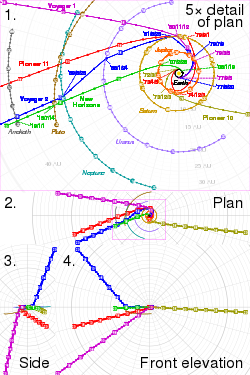
Plot 1 is viewed from the north ecliptic pole, to scale.
Plots 2 to 4 are third-angle projections at 20% scale.
In the SVG file, hover over a trajectory or orbit to highlight it and its associated launches and flybys.
Voyager 1 is a space probe launched by NASA on September 5, 1977, as part of the Voyager program to study the outer Solar System and the interstellar space beyond the Sun's heliosphere. It was launched 16 days after its twin, Voyager 2. It communicates through the NASA Deep Space Network (DSN) to receive routine commands and to transmit data to Earth. Real-time distance and velocity data are provided by NASA and JPL.[4] At a distance of 163.1 AU (24.4 billion km; 15.2 billion mi) from Earth as of June 2024[update],[4] it is the most distant human-made object from Earth.[5] The probe made flybys of Jupiter, Saturn, and Saturn's largest moon, Titan. NASA had a choice of either doing a Pluto or Titan flyby; exploration of the moon took priority because it was known to have a substantial atmosphere.[6][7][8] Voyager 1 studied the weather, magnetic fields, and rings of the two gas giants and was the first probe to provide detailed images of their moons.
As part of the Voyager program and like its sister craft Voyager 2, the spacecraft's extended mission is to locate and study the regions and boundaries of the outer heliosphere and to begin exploring the interstellar medium. Voyager 1 crossed the heliopause and entered interstellar space on August 25, 2012, making it the first spacecraft to do so.[9][10] Two years later, Voyager 1 began experiencing a third wave of coronal mass ejections from the Sun that continued to at least December 15, 2014, further confirming that the probe is in interstellar space.[11]
In 2017, the Voyager team successfully fired the spacecraft's trajectory correction maneuver (TCM) thrusters for the first time since 1980, enabling the mission to be extended by two to three years.[12] Voyager 1's extended mission is expected to continue to return science data until at least 2025, with a maximum lifespan of until 2030.[13] Its radioisotope thermoelectric generators (RTGs) may supply enough electric power to return engineering data until 2036.[14]
Mission background
History
A 1960s proposal for a Grand Tour to study the outer planets led NASA to begin work on a mission during the early 1970s.[15] Information gathered by the Pioneer 10 spacecraft helped engineers design Voyager to better cope with the intense radiation around Jupiter.[16] Still, shortly before launch, strips of kitchen-grade aluminum foil were applied to certain cables to improve radiation shielding.[17]
Initially, Voyager 1 was planned as Mariner 11 of the Mariner program. Due to budget cuts, the mission was reduced to a flyby of Jupiter and Saturn and renamed the Mariner Jupiter-Saturn probes. The name was changed to Voyager when the probe designs began to differ substantially from Mariner missions.[18]
Spacecraft components

Voyager 1 was built by the Jet Propulsion Laboratory (JPL). It has 16 hydrazine thrusters, three-axis stabilization gyroscopes, and referencing instruments to keep the probe's radio antenna pointed toward Earth. Collectively, these instruments are part of the Attitude and Articulation Control Subsystem (AACS), along with redundant units of most instruments and eight backup thrusters.[19] The spacecraft also included 11 scientific instruments to study celestial objects such as planets as it travels through space.[20]
Communication system
The radio communication system of Voyager 1 was designed to be used up to and beyond the limits of the Solar System. It has a 3.7-metre (12 ft) diameter high-gain Cassegrain antenna to send and receive radio waves via the three Deep Space Network stations on the Earth.[21] The spacecraft normally transmits data to Earth over Deep Space Network Channel 18, using a frequency of either 2.3 GHz or 8.4 GHz, while signals from Earth to Voyager are transmitted at 2.1 GHz.[22]
When Voyager 1 is unable to communicate with the Earth, its digital tape recorder (DTR) can record about 67 megabytes of data for later transmission.[23] As of 2023[update], signals from Voyager 1 take more than 22 hours to reach Earth.[4]
Power
Voyager 1 has three radioisotope thermoelectric generators (RTGs) mounted on a boom. Each MHW-RTG contains 24 pressed plutonium-238 oxide spheres.[24] The RTGs generated about 470 W of electric power at the time of launch, with the remainder being dissipated as waste heat.[25] The power output of the RTGs declines over time due to the 87.7-year half-life of the fuel and degradation of the thermocouples, but they will continue to support some of its operations until at least 2025.[20][24]
-
Diagram of RTG fuel container, showing the plutonium-238 oxide spheres
-
Model of an RTG unit
Computers
Unlike Voyager's other instruments, the operation of the cameras for visible light is not autonomous, but is controlled by an imaging parameter table contained in one of the digital computers, the Flight Data Subsystem (FDS). Since the 1990s, most space probes have been equipped with completely autonomous cameras.[26]
The computer command subsystem (CCS) controls the cameras. The CCS contains fixed computer programs, such as command decoding, fault-detection and fault-correction routines, antenna pointing routines, and spacecraft sequencing routines. This computer is an improved version of the one that was used in the 1970s Viking orbiters.[27]
The Attitude and Articulation Control Subsystem (AACS) controls the spacecraft orientation (its attitude). It keeps the high-gain antenna pointing towards the Earth, controls attitude changes, and points the scan platform. The custom-built AACS systems on both Voyagers are the same.[28][29]
Scientific instruments
| Instrument name | Abbr. | Description | ||||||||||||||||||||||||||||||||||||||||||||||||||||||||||||||||||||||||||||||||||||
|---|---|---|---|---|---|---|---|---|---|---|---|---|---|---|---|---|---|---|---|---|---|---|---|---|---|---|---|---|---|---|---|---|---|---|---|---|---|---|---|---|---|---|---|---|---|---|---|---|---|---|---|---|---|---|---|---|---|---|---|---|---|---|---|---|---|---|---|---|---|---|---|---|---|---|---|---|---|---|---|---|---|---|---|---|---|---|
| Imaging Science System (disabled) |
(ISS) | Used a two-camera system (narrow-angle/wide-angle) to provide images of Jupiter, Saturn and other objects along the trajectory.
| ||||||||||||||||||||||||||||||||||||||||||||||||||||||||||||||||||||||||||||||||||||
| Radio Science System (disabled) |
(RSS) | Used the telecommunications system of the Voyager spacecraft to determine the physical properties of planets and satellites (ionospheres, atmospheres, masses, gravity fields, densities) and the amount and size distribution of material in Saturn's rings and the ring dimensions.
| ||||||||||||||||||||||||||||||||||||||||||||||||||||||||||||||||||||||||||||||||||||
| Infrared interferometer spectrometer and radiometer (disabled) |
(IRIS) | Investigates both global and local energy balance and atmospheric composition. Vertical temperature profiles are also obtained from the planets and satellites as well as the composition, thermal properties, and size of particles in Saturn's rings.
| ||||||||||||||||||||||||||||||||||||||||||||||||||||||||||||||||||||||||||||||||||||
| Ultraviolet Spectrometer (disabled) |
(UVS) | Designed to measure atmospheric properties, and to measure radiation.
| ||||||||||||||||||||||||||||||||||||||||||||||||||||||||||||||||||||||||||||||||||||
| Triaxial Fluxgate Magnetometer (active) |
(MAG) | Designed to investigate the magnetic fields of Jupiter and Saturn, the interaction of the solar wind with the magnetospheres of these planets, and the magnetic field of interplanetary space out to the boundary between the solar wind and the magnetic field of interstellar space.
| ||||||||||||||||||||||||||||||||||||||||||||||||||||||||||||||||||||||||||||||||||||
| Plasma Spectrometer (defective) |
(PLS) | Investigates the microscopic properties of the plasma ions and measures electrons in the energy range from 5 eV to 1 keV.
| ||||||||||||||||||||||||||||||||||||||||||||||||||||||||||||||||||||||||||||||||||||
| Low Energy Charged Particle Instrument (active) |
(LECP) | Measures the differential in energy fluxes and angular distributions of ions, electrons and the differential in energy ion composition.
| ||||||||||||||||||||||||||||||||||||||||||||||||||||||||||||||||||||||||||||||||||||
| Cosmic Ray System (active) |
(CRS) | Determines the origin and acceleration process, life history, and dynamic contribution of interstellar cosmic rays, the nucleosynthesis of elements in cosmic-ray sources, the behavior of cosmic rays in the interplanetary medium, and the trapped planetary energetic-particle environment.
| ||||||||||||||||||||||||||||||||||||||||||||||||||||||||||||||||||||||||||||||||||||
| Planetary Radio Astronomy Investigation (disabled) |
(PRA) | Uses a sweep-frequency radio receiver to study the radio-emission signals from Jupiter and Saturn.
| ||||||||||||||||||||||||||||||||||||||||||||||||||||||||||||||||||||||||||||||||||||
| Photopolarimeter System (defective) |
(PPS) | Used a telescope with a polarizer to gather information on surface texture and composition of Jupiter and Saturn and information on atmospheric scattering properties and density for both planets.
| ||||||||||||||||||||||||||||||||||||||||||||||||||||||||||||||||||||||||||||||||||||
| Plasma Wave Subsystem (active) |
(PWS) | Provides continuous, sheath-independent measurements of the electron-density profiles at Jupiter and Saturn as well as basic information on local wave–particle interaction, useful in studying the magnetospheres.
| ||||||||||||||||||||||||||||||||||||||||||||||||||||||||||||||||||||||||||||||||||||
-
Voyager 1 'Proof Test Model' in a space simulator chamber at JPL 3/12/1976
-
Gold-Plated Record is attached to Voyager 1
-
Location of the scientific instruments indicated in a diagram
Mission profile
Timeline of travel
 Voyager 1's trajectory seen from Earth, diverging from the ecliptic in 1981 at Saturn and now heading towards the constellation Ophiuchus |
| Date | Event |
|---|---|
| 1977-09-05 | Spacecraft launched at 12:56:00 UTC. |
| 1977-12-10 | Entered asteroid belt. |
| 1977-12-19 | Voyager 1 overtakes Voyager 2. (see diagram) |
| 1978-09-08 | Exited asteroid belt. |
| 1979-01-06 | Start Jupiter observation phase. |
| 1979-03-05 | Encounter with the Jovian system. |
| 06:54 | Amalthea flyby at 420,200 km. |
| 12:05:26 | Jupiter closest approach at 348,890 km from the center of mass. |
| 15:14 | Io flyby at 20,570 km. |
| 18:19 | Europa flyby at 733,760 km. |
| 1979-03-06 | |
| 02:15 | Ganymede flyby at 114,710 km. |
| 17:08 | Callisto flyby at 126,400 km. |
| 1979-04-13 | Phase end |
| 1980-08-22 | Start Saturn observation phase. |
| 1980-11-12 | Encounter with the Saturnian system. |
| 05:41:21 | Titan flyby at 6,490 km. |
| 22:16:32 | Tethys flyby at 415,670 km. |
| 23:46:30 | Saturn closest approach at 184,300 km from the center of mass. |
| 1980-11-13 | |
| 01:43:12 | Mimas flyby at 88,440 km. |
| 01:51:16 | Enceladus flyby at 202,040 km. |
| 06:21:53 | Rhea flyby at 73,980 km. |
| 16:44:41 | Hyperion flyby at 880,440 km. |
| 1980-11-14 | Phase end |
| 1980-11-14 | Begin extended mission. |
| Extended mission | |
|---|---|
| 1990-02-14 | Final images of the Voyager program acquired by Voyager 1 to create the Solar System Family Portrait. |
| 1998-02-17 | Voyager 1 overtakes Pioneer 10 as the most distant spacecraft from the Sun, at 69.419 AU. Voyager 1 is moving away from the Sun at over 1 AU per year faster than Pioneer 10. |
| 2004-12-17
Zdroj:https://en.wikipedia.org?pojem=Mariner_11 Text je dostupný za podmienok Creative Commons Attribution/Share-Alike License 3.0 Unported; prípadne za ďalších podmienok. Podrobnejšie informácie nájdete na stránke Podmienky použitia.
Analytika
Antropológia Aplikované vedy Bibliometria Dejiny vedy Encyklopédie Filozofia vedy Forenzné vedy Humanitné vedy Knižničná veda Kryogenika Kryptológia Kulturológia Literárna veda Medzidisciplinárne oblasti Metódy kvantitatívnej analýzy Metavedy Metodika Text je dostupný za podmienok Creative
Commons Attribution/Share-Alike License 3.0 Unported; prípadne za ďalších
podmienok. www.astronomia.sk | www.biologia.sk | www.botanika.sk | www.dejiny.sk | www.economy.sk | www.elektrotechnika.sk | www.estetika.sk | www.farmakologia.sk | www.filozofia.sk | Fyzika | www.futurologia.sk | www.genetika.sk | www.chemia.sk | www.lingvistika.sk | www.politologia.sk | www.psychologia.sk | www.sexuologia.sk | www.sociologia.sk | www.veda.sk I www.zoologia.sk | |

